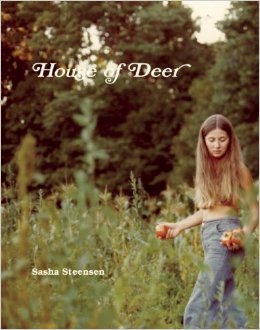What We’re Reading: House of Deer
 House of Deer by Sasha Steensen (Fence Books, 2014)
House of Deer by Sasha Steensen (Fence Books, 2014)
Sasha Steensen’s books are more lyric project than poetry collection. While many collections of poetry have themes that tie the poems together, Steensen’s books use their subject as a nexus around which the project grows, as if Steensen free-associated around the subject and developed individual pieces from there. House of Deer, Steensen’s intricate and lovely third collection, centers on her back-to-the-land childhood. Like her second collection, The Method (Fence Books, 2008), Steensen blends research and personal history through a process of addition, subtraction, and associative swerves.
House of Deer quotes, mentions, or makes references to Theresa Hak Kyung Cha, Gerard Manley Hopkins, George Oppen, and Baudelaire, among many others as a way to begin building (and it’s probable that this reader missed even more references). These connections are layered and reward repeated readings. The titular poem, “House of Deer,” mentions “the house on Hopkins Road,” where the reader assumes Steensen’s family lived; a later poem, “Fragments,” is noted as being written “after Hopkins.” This connection does not feel like an accident.
One of the more notable repeated references in House of Deer is Hart Crane, who was from Garrettsville, Ohio, where Steensen also grew up. His work and life become a starting point for Steensen to discuss familial tension, addiction, and self-destruction: “The family’s relationship with itself was strained. // This was meant to be a story about Hart Crane” (from “Fragments”). Later, Steensen quotes Crane (along with several other sources, all cited in parentheses in the text) in a piece called “Personal Poem Including Opium’s History,” which is dedicated to Steensen’s brother:
Instead, let’s talk about your closet full of weed.
If I could say sorry for that disclosure, I would.
But that’s too “the author-(to her brother)-to her book.”
Too Anne Bradstreet for me.
Yo-Ho! Sweet opium and tea (Hart Crane)
The Crane connection goes beyond a shared hometown. A “hart” is another term for a male deer; deer, like Crane’s life and work, serve as a way to enter into memory. Like deer, Steensen lived on the fringes—both of forest and mainstream culture—in a family unit that moved together: “sound of deer changing direction &then turning back,” as she writes in the section from which the book takes its name. Another section, “The Girl and the Deer,” is a retelling of a Zuni story. In it, Steensen tells “a story the writer cannot tell” of a girl, abandoned by her mother, being raised by a deer mother before her biological family kills her deer family and incorporates the girl back into their family.
Steensen’s method of composition could fall apart in any number of ways, but her attention to poetic lineage—the aforementioned references to Crane, Hopkins, et al—helps keep the project soaring (as it did in The Method). Further, Steensen displays a subtle attention to technique (learned, as she says in an interview with ZYZZYVA, from Crane). Take a standout piece like “A History of the Human Family:”
To find our First Family
what do we peer through,
what manhole or anthole?
what foxhole or portal?
what Afar Triangle?
It was 2.5 million years ago,
& it was eternal.
The intricate notice of sonic possibilities and meanings present here is found throughout the book adding a layer of complexity to the project that drives the reader forward.
Though Steensen’s method of composition may be very modern, she enters into dialogue with her influences and poetic-godparents. The effect is a complex, self-referential text that is as rewarding as it is difficult, which is to say very. Readers that enjoy layered poetic narrative will find a favorite author in Sasha Steensen.
What are your favorite “book projects,” as opposed to poetry collections?







Comments are closed.